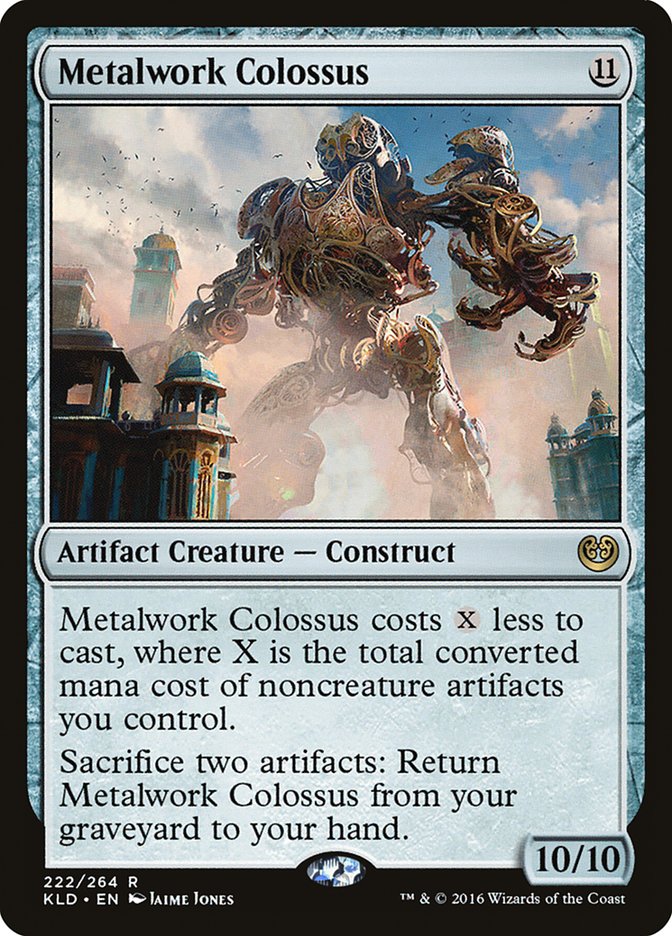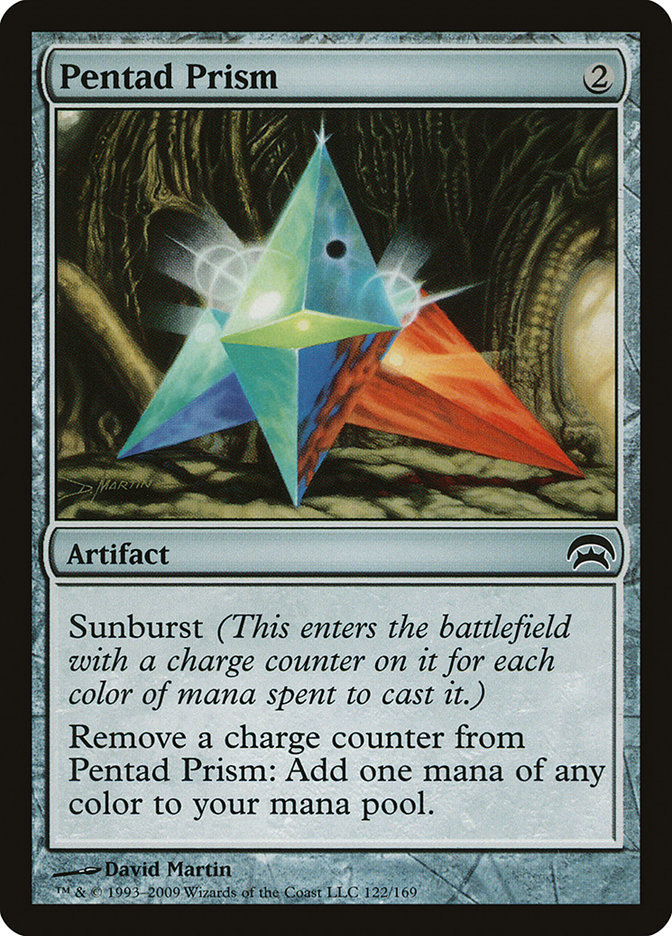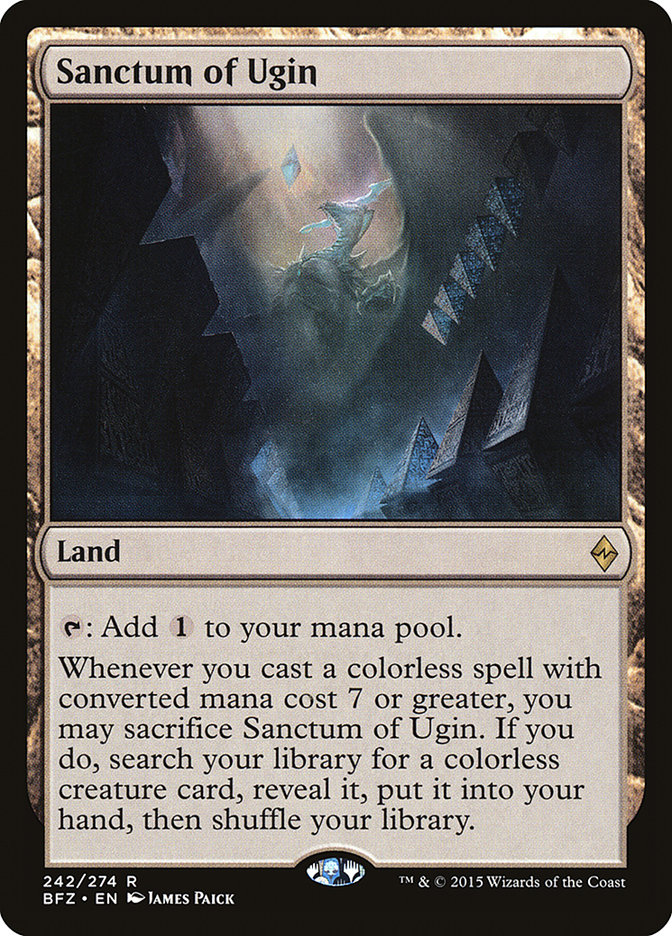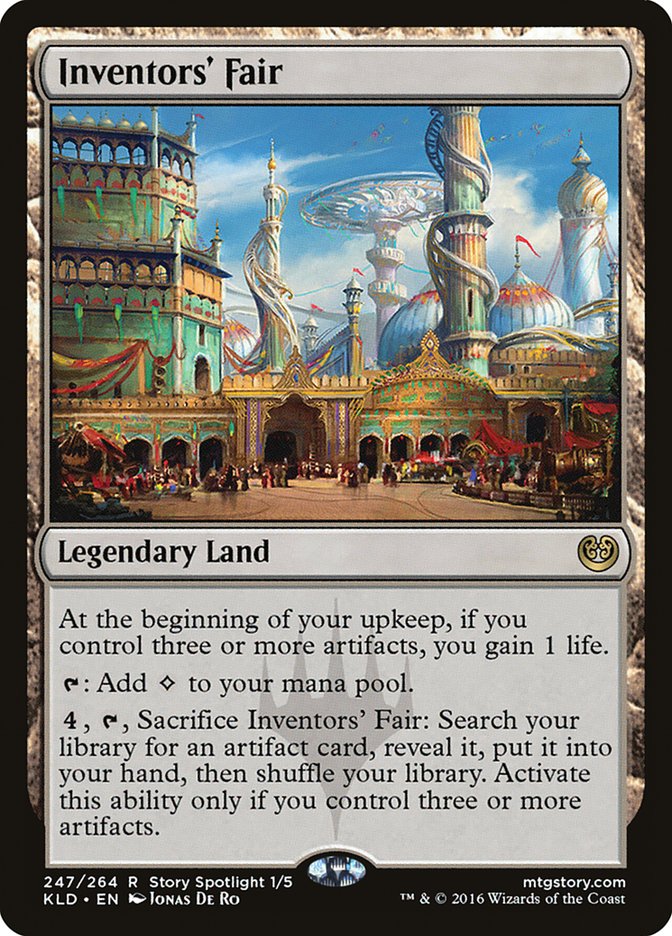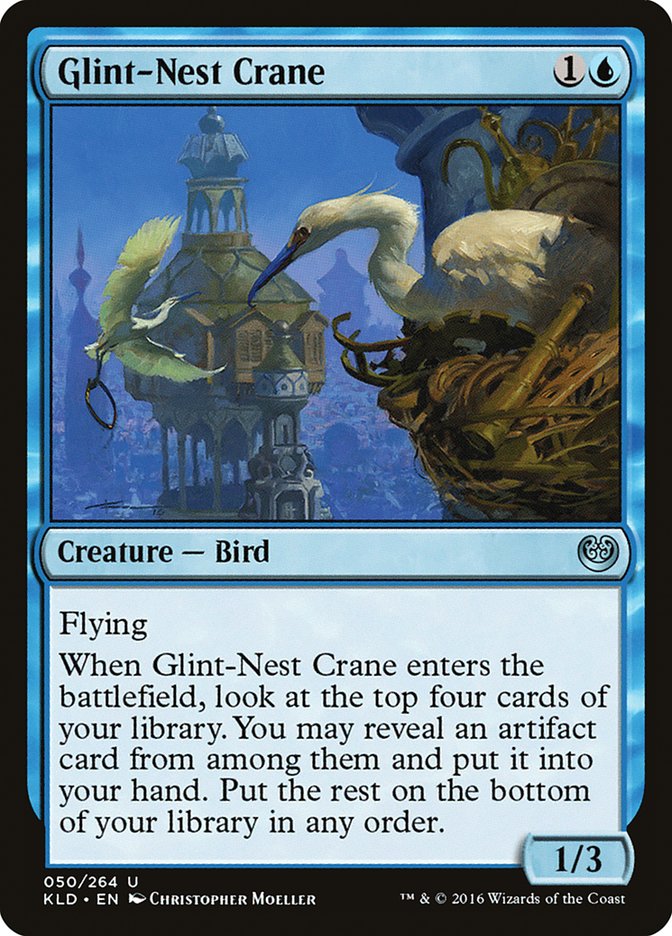Kaladesh has already made a sizable impact on Modern. Another cycle of powerful dual lands, Cathartic Reunion, Blossoming Defense, and Inventors’ Fair showing up in a handful of decks is a fairly impressive showing from a single set. As great as it is to see a shift in the way we build several established archetypes in the metagame, I just want to go deeper.
I haven’t had much of a chance up until this point to take a hard look at the way an artificer’s block can play with the massive card pool available to us in Modern, but today that’s going to change.
There are a couple of things worth noting before we get started. The first is that many of these lists will be light on interaction – instead attempting to be a “proof of concept” and push as hard as they can to accomplish their goal. While admittedly this makes decks weaker to aggressive creature combo decks like Infect and Death’s Shadow, I’m more in the market for presenting shells that can be fleshed out and often at times slowed down to adjust for the need to acknowledge those types of decks.
Secondly, it would appear that Modern is in a bit of a transition, shifting back to the slower more interactive strategies like Grixis and Jeskai Control that both put up top 8 results at the Grand Prix this past weekend. If playing traditional removal spells and slower strategies become popular, then working on these less creature-centric unfair decks makes a lot of sense.
Metalwork Colossus is a card that I’ve already laid a lot of ground work for in Standard, but any powerful threat that has the potential to be “free” is worth taking a look at in other contexts. In particular, one that can be combined with Ancient Stirrings is particularly enticing, as the G sorcery is probably the single most unfair velocity spell left in the entire format.
Creatures (10)
Lands (16)
Spells (34)

Gerry and I went pretty deep in our car ride with this one. In some respects, this is a decklist that shows a web of ideas that miraculously all end up leading in a similar direction. Tooth and Scale of Chiss-Goria are not great Magic cards, but they are “free” and that has the potential to be incredibly powerful when you’re working towards a pay-off like multiple 10/10s.
Myr Enforcer is a card that I’ve had my eye on since I started going wild with Sanctum of Ugin, and for the sake of being intuitive I’ll actually be showing off another decklist with it shortly, but it is yet another potentially free threat that can trigger Sanctum to back door you into a Colossus chain. Similarly, it alongside it’s larger brethren can be sacrificed to Eldritch Evolution to find the most dangerous Demon of all – which can let you completely explode and potentially “combo” even harder with Lightning Greaves.
Pentad Prism is probably the hardest working card here; it can produce a sizable amount of mana for your various artifact creatures while potentially even enabling a hardcast Griselbrand in longer contests.
This deck is wild and it undoubtedly will have some ugly openers, but the range available for trying to abuse a “free” card is massive.
I’ve actually spoken about this Myr Enforcer deck before, but I haven’t really put much effort into tuning it lately. I want to show it off again:
Creatures (28)
- 4 Arcbound Ravager
- 4 Myr Enforcer
- 1 Frogmite
- 4 Ornithopter
- 3 Memnite
- 4 Signal Pest
- 4 Vault Skirge
- 3 Bygone Bishop
- 1 Elder Deep-Fiend
Lands (18)
Spells (14)
Sideboard

In some respects this take on Affinity is sacrificing its speed or perhaps “free wins” by eschewing Etched Champion and Steel Overseer for a great deal of resiliency in Bygone Bishop, Myr Enforcer, and Sanctum of Ugin. Being able to initiate a chain of free 4/4s is powerful, and the option to disrupt decks with Elder Deep-Fiend can grant you the additional turn that is necessary to stop what your opponent is doing.
I’m not advocating that one is better than the other; just that the option to think outside the box is there as new cards get printed. Myr Enforcer was once a staple of the archetype, and while now it is considered worse than many of the cheaper cards that have been printed over the last several years, the context of everything can change with simply another printing, in this case Sanctum of Ugin.
I should clarify that I have no delusions that Frogmite will ever be a reasonable tutor target, it is simply another bridge card for moving towards your powerful top end. I don’t believe this deck wants many copies because the card is generally underwhelming and also doesn’t synergize with Bygone Bishop.
A deck that I’ve been slowly brewing up and working on is a new take on Krark-Clan Ironworks. I think that Aetherworks Marvel slots beautifully in the deck.
Creatures (2)
Lands (18)
Spells (40)

There have been several iterations of “KCI” over the years, but for the most part they are interested in utilizing their namesake to make extremely large amounts of mana, use Faith’s Reward or Open the Vaults to create more mana and generate tons of additional cards, and end the game with some kind of loop or Emrakul, the Aeons Torn.
In this case, I’m excited about the use of Aetherworks Marvel because it synergizes so well with the deck’s general game plan.
Aetherworks has the potential to just “spike” here: You can simply find a recursion spell or win condition, but it also makes it so that it is nigh-impossible to fizzle your combo once you start going off. Ironworks allows Aetherworks Marvel to effectively loop every cycle by both gaining energy through your sacrificing various trinkets, but also “resetting” the Marvel so that it is untapped and ready to be used – effectively giving the deck 6 additional “draws” every time you cast a recursion spell.
That kind of built in redundancy is exciting; it’s just a matter of whether the deck’s general speed is high enough to compete these days. I’m not exactly sure the answer to that question, but even the simple addition of Woodweaver’s Puzzleknot into the deck allows you to buy time and potentially even gain an arbitrarily large amount of life just by working through your combo.
The movement towards hate cards like Relic of Progenitus to fight Dredge is certainly threatening, but it wouldn’t surprise me if there was a time to look at this deck seriously.
Despite the fact that Aetherworks Marvel requires you to play a fairly high density of new and often times underpowered cards to enable it, the ceiling on the card is utterly ridiculous, and I want to take a look at a “dedicated” version of Marvel for Modern:
Creatures (7)
Lands (20)
Spells (33)

Perhaps the largest issue with the Standard version of Marvel is how frequently the deck suffers from drawing virtually uncastable cards. Further, the deck is required to play a high density of those large powerful threats to simply sustain its game plan. To some extent, a Modern version fixes several of those issues while also benefitting from the incredible power level of Ancient Stirrings.
Is Through the Breach/Emrakul the best combination of heavy hitters we can play? I’m not entirely sure, to be honest, but the ability to hit Emrakul or Through the Breach with the former in your hand gives you a lot more range for ending the game quickly with Marvel. I also like that this deck actually has some room for multiple pieces of interaction alongside the ability to stall with Woodweaver’s Puzzleknot. Further, other than the lingering threat of Stony Silence, this deck isn’t subject to a ton of hate cards, even potential issues like Ensnaring Bridge can be worked around.
Speaking of, I’m a fan of how many folks constructed their Lantern decks for the Grand Prix this past weekend. The incorporation of new tools like Inventors’ Fair and Glint-Nest Crane, which largely inspired this deck, are certainly enough to get me interested in working on that deck in the future.
Despite winning our last Invitational (where Liam en route beat the crap out of me), Elves seems to consistently be an underrated Modern deck. It’s just generally a lot faster and more resilient than its opponents give it credit for, often requiring that one goes cleanly over the top of it.
While Shaman of the Pack isn’t necessarily a set in stone staple for the archetype, I think its potential with Panharmonicon is massive.
Creatures (33)
- 4 Llanowar Elves
- 1 Eternal Witness
- 4 Heritage Druid
- 4 Nettle Sentinel
- 4 Elvish Visionary
- 4 Elvish Archdruid
- 1 Ezuri, Renegade Leader
- 4 Elvish Mystic
- 1 Reclamation Sage
- 3 Dwynen's Elite
- 3 Shaman of the Pack
Lands (19)
Spells (8)

I’m certainly not an expert on the archetype, but this just looks so powerful to me. How can one ever hope to grind this deck out by traditional means should it ever resolve the four mana artifact? Even if you don’t immediately die in a hail of Elf-fueled triggers, every Visionary drawing two cards is likely to find a way to play Eternal Witness, which is just filthy for refueling and setting up the aforementioned Shaman.
The last deck I have for today is just something I’ve been wanting to put on paper for the past month. Imagine my surprise to find out that not only did Skred Red win Grand Prix Dallas but it didn’t have any copies of Boros Reckoner! Despite that, I’ve been wanting to gain infinite life with this simple combination:
Creatures (10)
Planeswalkers (4)
Lands (23)
Spells (23)

The shell might not be the cleanest, but the simple idea here other than effectively being a Jund variant is that Rush of Vitality + Boros Reckoner and the smallest gust of wind will equate in Reckoner continuing to shoot himself over and over to gain infinite life. This was showcased to some extent back in Ravnica Standard by combining Boros Charm and Azorius Charm, but here we get both effects for the easy cost of 1B!
Good? I’m not sure, but it’s definitely cool, and it’s yet another interaction to keep an eye out for when taking a look at the effects of Kaladesh on Modern.
#SCGCOL is this weekend and I’m not sure what to play. Whether it’s running back Scapeshift or trying my hand at something new, I suspect there’s a good chance Kaladesh will be in the fold.


